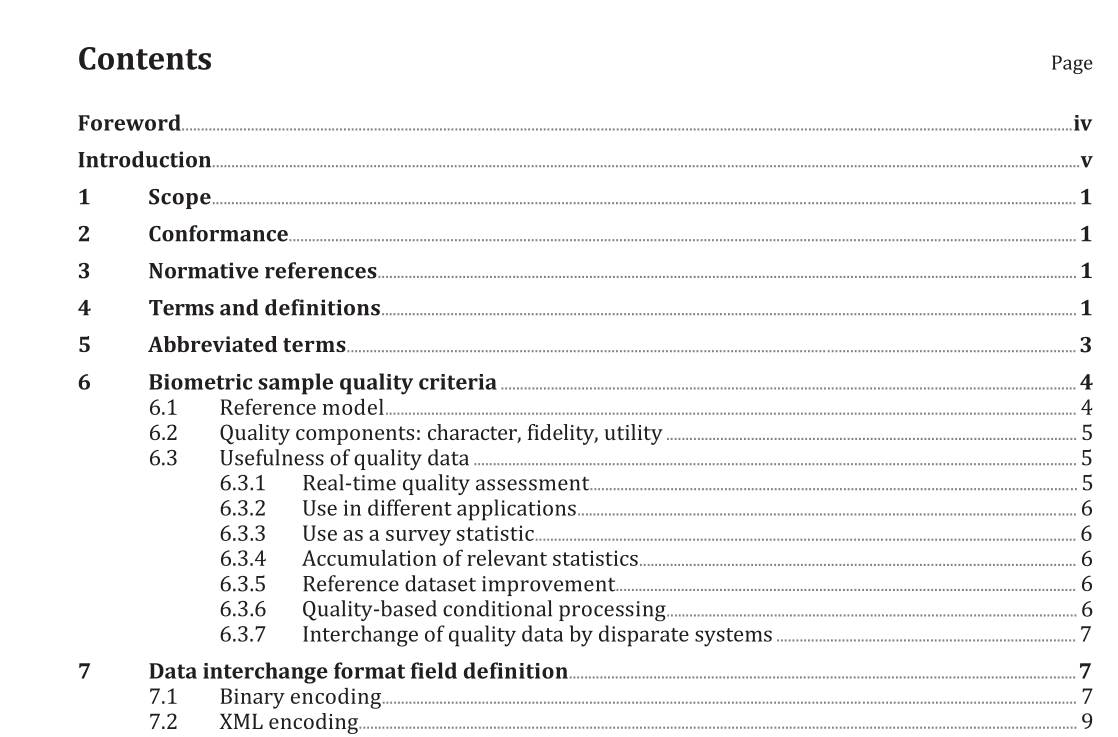BS ISO IEC 29794-1 pdf download.Information technology — Biometric sample quality
1 Scope
This part of ISO/IEC 29794, for any or all biometric sample types as necessary, establishes the following: — terms and definitions that are useful in the specification and use of quality metrics; — purpose and interpretation of biometric quality scores; — encoding of quality data fields in biometric data interchange formats; — methods for developing biometric sample datasets for the purpose of quality score normalisation; — format for exchange of quality algorithm results; — methods for aggregation of quality scores. The following are outside the scope of this part of ISO/IEC 29794: — specification of minimum requirements for sample, module, or system quality scores; — performance assessment of quality algorithms; — standardization of quality algorithms.
2 Conformance
A biometric sample quality record shall conform to this part of ISO/IEC 29794 if its structure and data values conform to the formatting requirements of Clause 7. Conformance to normative requirements of 7.1 and 7.2 fulfils Level 1 and Level 2 conformance as specified in ISO/IEC 19794-1:2011, Annex A. Conformance to normative requirements of 7.3 is Level 3 conformance as specified in ISO/IEC 19794- 1:2011, Annex A.
4 Terms and definitions
For the purposes of this document, the terms and definitions given in ISO/IEC 2382-37, ISO/IEC 19794-1 and the following apply.4.1 acquisition fidelity fidelity (4.6) of a sample attributed to the acquisition process 4.2 character contributor to quality (4.11) of a sample attributable to inherent properties of the source (4.17) 4.3 environment physical surroundings and conditions where biometric capture occurs, including operational factors such as operator (4.9) skill and enrolee cooperation level 4.4 extraction fidelity component of the fidelity (4.6) of a sample attributed to the biometric feature extraction process 4.5 extrinsic when used to describe a quality score (4.12), requiring reference to an external source (4.17), such as a standard, register, or technical specifications for full interpretation (4.8) and normalisation 4.6 fidelity expression of how accurately a biometric sample represents its source (4.17) biometric characteristic Note 1 to entry: The fidelity of a sample comprises components attributable to one or more of the processing steps: acquisition, extraction, signal processing. 4.7 intrinsic when used to describe a quality score (4.12), conveying fully interpreted (4.8), normalised data without the requirement for additional extrinsic (4.5)information for quality score normalisation (4.13) 4.8 interpretation process of analysing a quality score (4.12) along with other data in order to give that score contextual, relative meaning 4.9 operator individual who processes a capture subject in a biometric system, performing or supervising capture and recapture 4.10 performance assessment of false match rate, false non-match rate, failure to enrol rate and failure to acquire rate of a biometric system 4.11 quality degree to which a biometric sample fulfils specified requirements for a targeted application Note 1 to entry: Specified quality requirements may address aspects of quality such as focus, resolution, etc. Implicit quality requirements address the likelihood of achieving a correct comparison result. 4.12 quality score quantitative expression of quality (4.11)
6 Biometric sample quality criteria
6.1 Reference model In biometrics, the term “quality” is used to describe several different aspects of a biometric sample that contribute to the overall performance of a biometric system. For the purposes of standardization, this part of ISO/IEC 29794 defines terms, definitions, and a reference model for distinguishing between these different aspects of quality, illustrated in Figure 1. Figure 2 illustrates the relationship between character, fidelity, quality, utility, and system performance.6.2 Quality components: character, fidelity, utility The term “quality” as it is currently used in the field of biometrics has several connotations, depending on context. Three prevalent uses are to subjectively reflect the following. a) Character of a sample. An expression of quality based on the inherent properties of the source from which the biometric sample is derived. For example, a scarred fingerprint has poor character and blepharoptosis (droopy eyelid) causes poor iris character. b) Fidelity of a sample to the source from which it is derived. An expression of quality based on fidelity reflects the degree of its similarity to its source. Sample fidelity is comprised of fidelity components contributed by different processes. c) Utility of a sample within a biometric system. An expression of quality based on utility reflects the predicted positive or negative contribution of an individual sample to the overall performance of a biometric system. Utility-based quality is dependent on both the character and fidelity of a sample. Utility–based quality is intended to be more predictive of system performance, e.g. in terms of false match rate, false non-match rate, failure to enrol rate, and failure to acquire rate, than measures of quality based on character or fidelity alone. See Table 1. The term “quality” should not be solely attributable to the acquisition settings of the sample, such as image resolution, dimensions in pixels, grey scale/colour bit depth, or number of features. Though such factors can affect sample utility and could contribute to the overall quality score. Note that the character and utility of an acquired sample depend on the features to be considered by the comparator. For instance, the same finger image may be of low character and utility with respect to minutiae recognition (because of too few minutiae), but of high character and utility with respect to spectral pattern recognition.
BS ISO IEC 29794-1 pdf download
